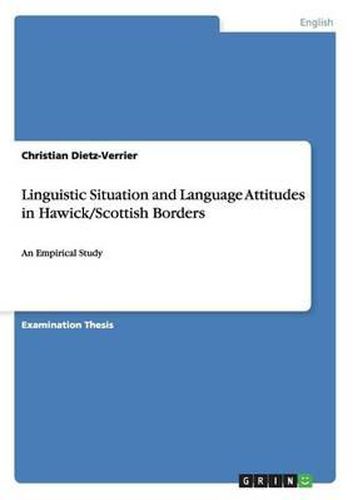Readings Newsletter
Become a Readings Member to make your shopping experience even easier.
Sign in or sign up for free!
You’re not far away from qualifying for FREE standard shipping within Australia
You’ve qualified for FREE standard shipping within Australia
The cart is loading…






Examination Thesis from the year 2003 in the subject English Language and Literature Studies - Linguistics, grade: 1.0, University of Heidelberg (English Department), course: English Linguistics, language: English, abstract: The present analysis will focus on two major aspects: the local vernacular as employed in Hawick and its usage in the school context. The emphasis lies on the present linguistic situation in terms of language usage and attitudes of both pupils and teachers. The second chapter will supply a brief social, linguistic and historical outline of Hawick and Southern Scots. Subsequently, in the third chapter the methodology and aspects of language attitudes and their measurement will be described. The fourth chapter, being the main part of the study, is subdivided into two sections. Firstly, the linguistic situation in Hawick in general will be illustrated, and extralinguistic variables are taken into account whenever they prove to be statistically significant. The final part of the analysis, chapter 4.2, will clarify language use and attitudes towards the vernacular in the school context. The conclusion in chapter five will summarize the most important results and might also serve as an impetus for further dialect and attitude studies.
$9.00 standard shipping within Australia
FREE standard shipping within Australia for orders over $100.00
Express & International shipping calculated at checkout
Examination Thesis from the year 2003 in the subject English Language and Literature Studies - Linguistics, grade: 1.0, University of Heidelberg (English Department), course: English Linguistics, language: English, abstract: The present analysis will focus on two major aspects: the local vernacular as employed in Hawick and its usage in the school context. The emphasis lies on the present linguistic situation in terms of language usage and attitudes of both pupils and teachers. The second chapter will supply a brief social, linguistic and historical outline of Hawick and Southern Scots. Subsequently, in the third chapter the methodology and aspects of language attitudes and their measurement will be described. The fourth chapter, being the main part of the study, is subdivided into two sections. Firstly, the linguistic situation in Hawick in general will be illustrated, and extralinguistic variables are taken into account whenever they prove to be statistically significant. The final part of the analysis, chapter 4.2, will clarify language use and attitudes towards the vernacular in the school context. The conclusion in chapter five will summarize the most important results and might also serve as an impetus for further dialect and attitude studies.